Teaching narrative hooks is fun, and students are excited to start. Rarely does it all go perfectly; there are always students who get it, students who are almost there, and the few who need loads of scaffolding. This is true of every lesson in every class, but it can suck the fun out of writing – which is not what I want! Over the years, I have tried different strategies and activities but always come back to some tried and true strategies. Here are some tips to get and keep students excited and engaged when writing narrative hooks. Narrative Writing Hooks is a resource that will provide everything you need to teach hooks like a pro!
A side note – before my students learn about hooks we have been brainstorming and planning topics for narrative writing. Usually, my students have a plot diagram filled in and even a start to the narrative. I like them to have a narrative waiting for them after I teach hooks in narrative writing so they can apply the learning immediately to their writing.
1. Introduce Narrative Hooks with Notes & Examples
Talk about fun being sucked out of a room – ask students to take notes! Making notes quick and simple will alleviate a lot of work and provide a resource students can keep throughout the year, making it worth the effort and time.
Interactive Notes
Coloring, cutting, and gluing gives students a hands-on activity and makes writing notes less daunting and the information easily digestible.

Ready-Made Notes for Reference
Handing students notes that are done for them saves time and stress. A presentation and class discussion about the notes will help reinforce the information provided on the ready-made notes. Find a presentation and ready-made notes in the Narrative Writing Hooks resource here.
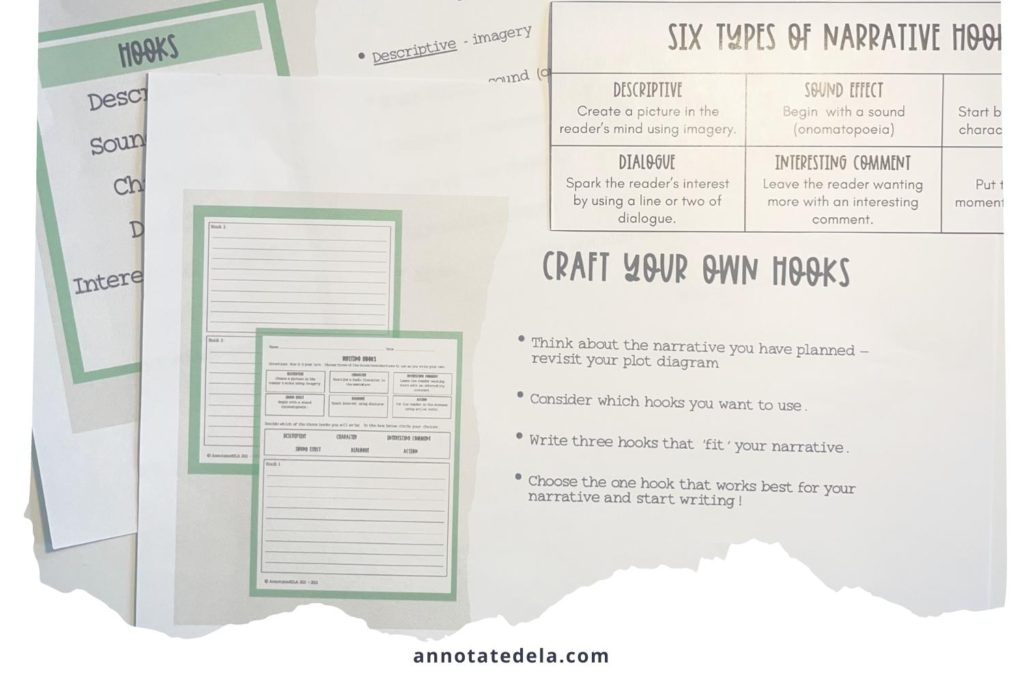
2. Identify and Analyze Narrative Hooks – Scavenger Hunt
After taking notes and teaching hooks in narrative writing, get students up and thinking about what narrative hooks look like in action. It’s called a scavenger hunt, but it’s just stations set up around the room and hallway that highlight the 6 types of hooks – students don’t mind what it’s called because they hear scavenger hunt, and they are already engaged; you can grab the Narrative Writing Hooks Scavenger Hunt as part of the Narrative Writing Hooks resource here!
The students move through the stations and identify the hooks with a quick sentence that explains which hook it is and how the students know it is that type of hook.
Then gather as a class and debrief. Ask students to identify the hooks and discuss why the hook is effective or ineffective. There is always some discussion about hooks being more than one type, and this is important, because the hooks tend to be elements of each other.
If there is no time for this activity, read the first few lines from the books or use the beginnings from the book in the scavenger hunt and complete the activity as a whole class.
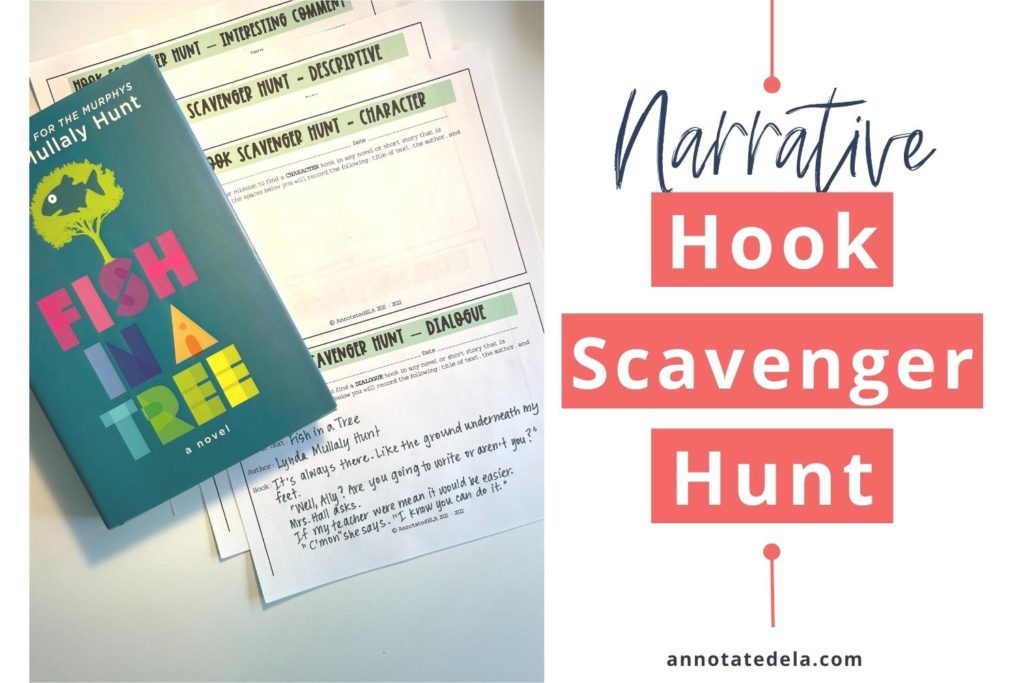
3. Practice Narrative Hooks
This is a favorite!! The students have a chance to be creative and practice (I will sometimes skip the scavenger hunt and go straight to practice – I let the student’s ability guide my decision).
Suggested book: The Mysteries of Harris Burdick by Chris Van Allsburg, but you could use pictures from anywhere (news stories, magazines, etc). The students are always so enchanted by the story of a man who drops off ideas for stories and then never returns.
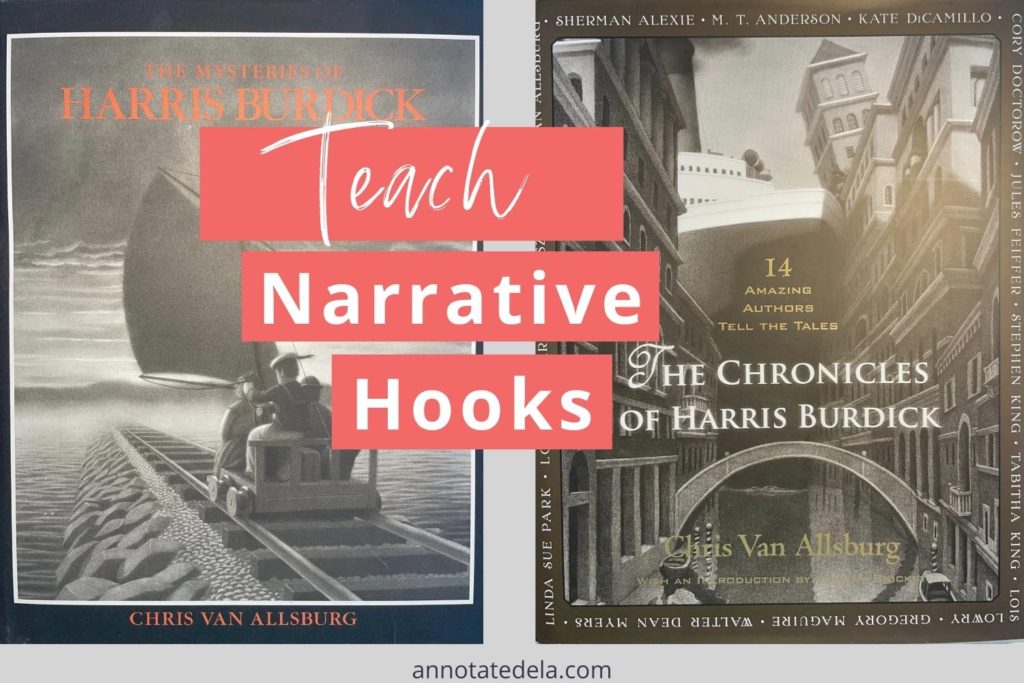
- Pair students or make groups of three for this activity.
- Introduce the book – read the introduction.
- Hand out a picture to each group.
- The students choose a type of hook and write a hook for the picture.
- Pass pictures to the right and continue on until the groups have had a chance to practice three to four of the six narrative hook types.
Finally, the students go around and share the group’s hook and the picture it goes with. The other groups make guesses on which narrative hook was used.
In the end, read the title and the one sentence that actually goes with the picture. The students will discuss which type of hook was used and if they like the hook. This is a great time to evaluate published writers. They are reading like writers!
We always enjoy this lesson. As we continue through the year, I read The Chronicles of Harris Burdick by Chris Van Allsburg and fourteen other authors who decided to bring the pictures and the sentences from The Mysteries of Harris Burdick to life.
Modify the practice lesson to fit your student’s needs. Here is a possible modification:
- Put students in groups of two or three.
- Pass out one picture from The Mysteries of Harris Burdick to each group of students
- Have the groups craft a hook
- Hang the hooks around the classroom next to the picture (or post in your online learning platforms – JamBoard, Padlet, etc)
- Have classmates evaluate hooks and provide feedback.
This modification saves time and creates an authentic audience for the student’s writing.
Need to modify even more? Check out the Narrative Writing Hooks resource here. There are before and after hooks already written for students to evaluate and use as examples and make teaching narrative hooks a breeze.
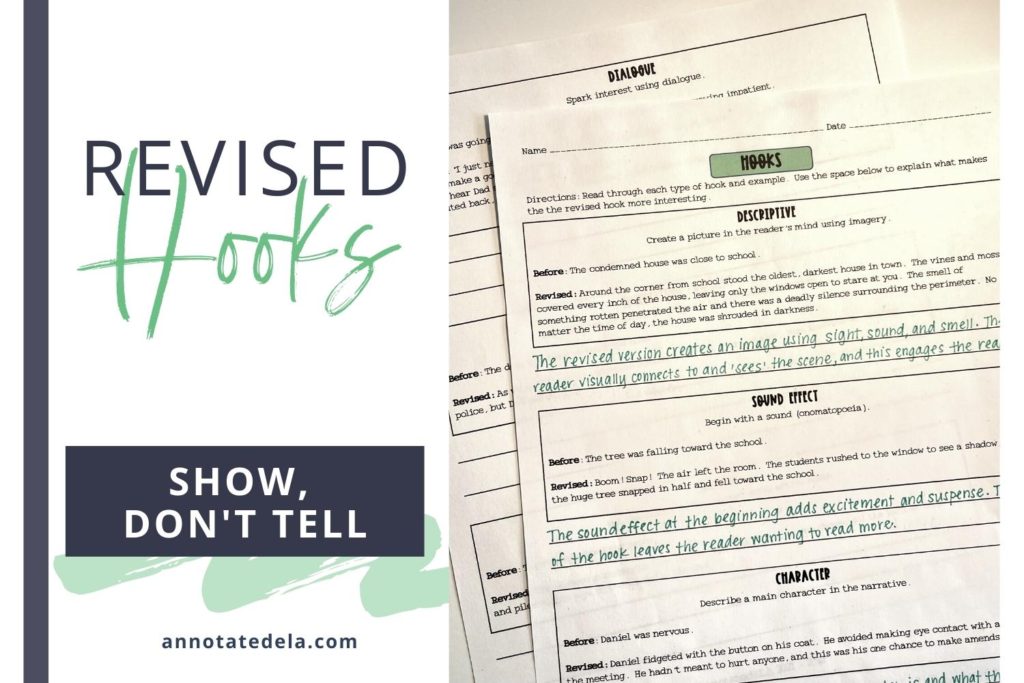
4. Brainstorm
As a class, brainstorm one example of each hook type on an anchor chart or pull small groups while the class works on their narratives. Either way, having a visual in the room for each hook is always helpful and provides an opportunity to write as a class.
Co-writing with the class is a great formative assessment. You can quickly gauge students’ ability and comfort level with drafting hooks for narrative writing. It also creates a writing community! Nothing is more rewarding than producing as a class.
Finally, brainstorming opens a final conversation about what makes a great hook. The class talks about adding details, focusing on the plot and storyline, and thinking like a writer because they are taking the reader into consideration when they write.
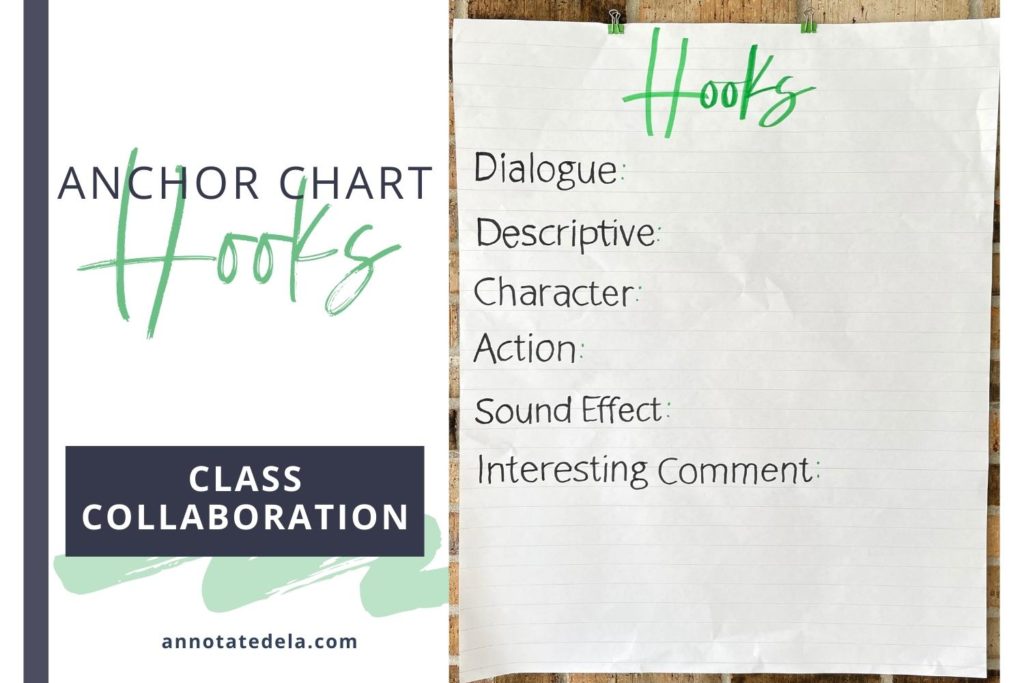
5. Write Narrative Hooks
It’s time; teaching narrative hooks has led to this!! Have the students write hooks for their narrative. Having a plot diagram or even a draft of the narrative is essential for writing hooks because the narrative hook not only captures the reader’s attention but also introduces the reader to the story. If you are looking for plot diagram ideas, check out the resource Plot Diagram for Narrative Writing.
The students write three different narrative hooks for class, choosing from the notes they have taken. While students are drafting hooks, call small groups and individual students to conference on their narrative and hooks. Take this precious time to teach narrative hooks and fill gaps you have noticed throughout the note-taking and practice activities.
Students complete hooks and get with a partner to share what each has written and provide positive feedback on the narrative hooks. Finally, the students write the ‘winning’ narrative hook on an exit ticket and turn it in before leaving class.
The ‘winning’ narrative hook on the exit ticket allows the teacher to review students learning and provide feedback for teaching narrative hooks.
Having a chance to provide feedback is the golden ticket
- Immediate feedback for students
- Opportunity to plan to re-teach or provide an extension for small groups or whole class
- Reduces grading time at the end of the writing assignment
- Confidence in writing and ability to make changes
Tip for Hooks
Hooks are usually the last thing the students do; having the entire narrative written helps students have a complete understanding of the plot and storyline and focuses the hook. This step provides more clarity and focus for the students to write hooks.
Take this tip a step further and have the students write a one to two-sentence summary of their plot. This helps focus the students on the meat of the story and improves the hook. Writing the hook AFTER the story allows the writer to be clear on how to hook the reader.
I have questioned if teaching hooks in narrative writing this way is worth the time. There is so much pressure to keep moving, focus on the standards, and improve scores. Here is my mantra: “I am teaching writers, not the writing” and “I am teaching readers, not the reading.”
The humans in front of me and their needs guide my instruction. If pieces of this lesson are not necessary for a group of students – skip it. If some students need the practice, use it in a small group or make it a mini-lesson during Writer’s Workshop as a review. Please use what you and your students need and leave the rest!!
Here’s to the magic of writing!




3 Responses